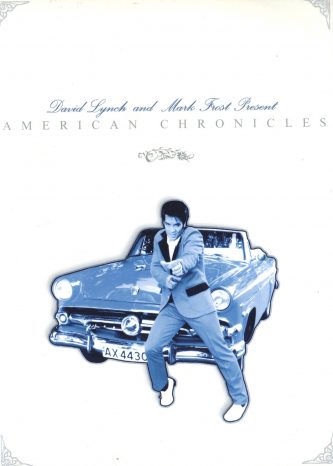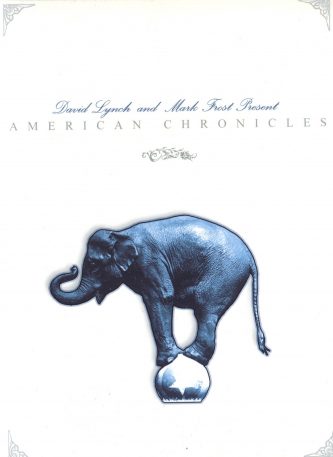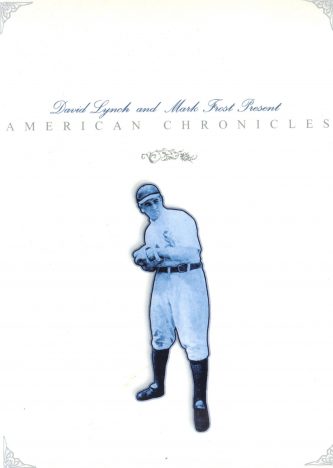 For David Lynch fanatics AMERICAN CHRONICLES is something of a holy grail. A half hour documentary program produced by Lynch/Frost Productions, it was one of three failed TV series that followed in the wake of TWIN PEAKS (the others were 1992’s ON THE AIR and ‘93’s HOTEL ROOM). AMERICAN CHRONICLES premiered on the Fox Network on September 8, 1990 and aired its twelfth and final episode on January 1, 1991, with a thirteenth broadcast in Europe on June 6, 1992. Ratings-wise it apparently came in dead last amid the 98 programs with which it was ranked.
For David Lynch fanatics AMERICAN CHRONICLES is something of a holy grail. A half hour documentary program produced by Lynch/Frost Productions, it was one of three failed TV series that followed in the wake of TWIN PEAKS (the others were 1992’s ON THE AIR and ‘93’s HOTEL ROOM). AMERICAN CHRONICLES premiered on the Fox Network on September 8, 1990 and aired its twelfth and final episode on January 1, 1991, with a thirteenth broadcast in Europe on June 6, 1992. Ratings-wise it apparently came in dead last amid the 98 programs with which it was ranked.
Mark Frost, the second half of Lynch/Frost Productions, has complained about being marginalized in his role as co-creator of TWIN PEAKS (quote: “there were times…when I was doing almost all the work on TWIN PEAKS…but David had a much higher profile”), and he could certainly make the same complaint about AMERICAN CHRONICLES. The program was created and executive produced by Frost, yet Lynch’s name is the one that always gets attached to it. See the imdb plot summary, which erroneously credits Lynch as the “director” of a series that apparently gave its subjects the “Lynch treatment,” when in fact Lynch by all accounts had little-to-no involvement with AMERICAN CHRONICLES outside co-directing a single episode (the last one).
AMERICAN CHRONICLES opens in decidedly haunting fashion, with ominous synthesizer music and a close-up of an eyeball superimposed over a cloudy sky. It makes for a not-very-appropriate set-up to a series consisting of what have become known as essay films, i.e. moody and eccentric mini-documentaries in the mold of filmmakers like Errol Morris and Godfrey Reggio. Are they any good? Let’s see.
The series commenced with “Farewell to the Flesh,” written and directed by Mark Frost. It effectively set the tone for the subsequent episodes in its depiction of Mardi Gras, presented via rather pedestrian video footage of the event decked out with excess dissolves, step framing and music cues from “Carmina Burana” and “Sing Sing Sing,” imparting a self-conscious and rather detached air that fits in quite well with the pretentious narration by Richard Dreyfuss (which includes morsels like “the psychological effect of the costume or mask frees up something deep inside the human psyche…spirits soar…something primitive, frenzied and joyful is unleashed…Mardi Gras day is at hand!”). There’s also a brief history lesson showing how Mardi Gras came to be, visualized with computerized animation that was probably quite expensive back in 1990 (as evinced by the fact that such animation doesn’t turn up in any of the subsequent episodes).
Next up was “The Eye of the Beholder,” on which no director is credited (the first of several director-less episodes). It looks at a San Antonio, TX beauty pageant in a montage-heavy treatment that allows for a good eyeful of some hilariously dated late 1980s fashions and hairdos. It was followed by “Manhattan After Dark,” written and directed by Robin L. Sestro (who went on to become a prolific reality TV producer), who offers a shockingly tame look at just what the title says that’s of interest only because it dispenses with the Richard Dreyfuss narration in favor of a late night DJ’s thoughts on New York City and its nightlife.
Dreyfuss is back, though, for “Auto-Obsession.” Written and directed by Marlo Bendau, it’s about car love (“Americans and their cars…they  do more than drive them, they dream about them, they slave over them, they love them, often to the exclusion of everything else”) whose canvas is far too broad—in addition to car love, it contains asides on Nascar and oil consumption—to make a full impression. “Biker Nation” is another episode in which no director is credited. It explores a yearly biker gathering in Sturgis, South Dakota, which one participant likens to Christians heading to Jerusalem. Once again: it’s not much.
do more than drive them, they dream about them, they slave over them, they love them, often to the exclusion of everything else”) whose canvas is far too broad—in addition to car love, it contains asides on Nascar and oil consumption—to make a full impression. “Biker Nation” is another episode in which no director is credited. It explores a yearly biker gathering in Sturgis, South Dakota, which one participant likens to Christians heading to Jerusalem. Once again: it’s not much.
“Semper Fidelis,” written and directed by Sestro, is an above-average entry. It looks in on a Marine boot camp in a straightforward manner that’s less affected than its fellows, although it contains all the expected dissolves, historical asides and eccentric music cues (including a Mandy Patinkin cover of “Pennies from Heaven”). Yet it also features an interview with the late drill sergeant-turned-actor R. Lee Ermey, which alone makes it worthwhile.
With episode seven the series went in a new direction, packing two fifteen minute episodes into its half hour slot. The first of them was “This Gun’s for Hire,” written and directed by the late Chappy Hardy (an associate producer on the Mark Frost directed STORYVILLE), about a soldier of fortune convention in Las Vegas that offers scant insight into the lifestyle (among the shallow tidbits we get from the participants are “We’re doers not talkers” and “There’s a thrill in blowing something up”). It’s paired with “Defender of the Faith,” yet another director-less episode, this one offering an extremely hero-worshippy profile of “America’s Fighter” George Foreman.
The next two-for commences with the director-less “After A Fashion,” about the fashion industry. Lots of montages of women posing in no-longer-fashionable outfits pack this episode. “An American Camelot,” which is once again director-less, explores life in Beverly Hills, and is most interesting for the Philip Glass music that plays over it, and also the narration proclaiming that in BH the average salary is “137,000 dollars a year” and houses there go for “560,000 dollars.” Imagine that!
“Here Today, Gone Tomorrow” (no director, again) can’t help but be at least somewhat interesting due to its subject matter: a travelling circus, a great deal of footage from which is shown, interspaced with interviews with clowns and promoters who insist on viewing what they do as something profound (“People want to be part of Americana…the circus was here long before there was anything else”). “Truck Stop” (also director-less) is a fluffy lark about truck stops–to whit: “like some mythical siren’s lure, their neon signs promise nourishment for both man and machine.”
“Once Upon A Time” was apparently judged strong enough to get a whole half hour slot to itself. It’s a shameless puff piece about Playboy’s late founder Hugh Hefner with, yet again, no credited director. It was padded to feature length and released in 1992 as HUGH HEFNER: ONCE UPON A TIME, with James Coburn replacing Richard Dreyfuss as narrator and Robert Heath taking directorial credit. The initial televised cut is stronger and more succinct, although neither version is especially deep or insightful.
“Class of ‘65,” which focused on a 25 year reunion at a Midwestern high school, is another director-less episode that takes up an entire half hour. It’s arguably the only one of them with any real emotional resonance, with its fortyish principals musing at length about their teenaged selves and the world in which they grew up, at one point recreating photographic poses from their high school yearbook. Not especially interesting, perhaps, in and of itself, but nostalgia is something we all feel, and is quite powerfully evoked here.
 The ho-hum “Diamonds are Forever” (no director) commences the second to final episode, another two-parter. It’s about the last day of the iconic Comiskey Park stadium (home to the Chicago White Sox), making for an especially sappy, overly wistful fifteen minutes that, unlike “Class of ‘65,” fails to impart any emotional resonance to the viewer—it’s notable, though, for a catchy music score by Billy Barber. “The Future that Never Was,” (again no director), consists of analyses of old movie and TV clips about the future, which tend to be absurdly optimistic about the uses and effects of technology. Not uninteresting, but the episode exists purely on the level of an old timey educational short.
The ho-hum “Diamonds are Forever” (no director) commences the second to final episode, another two-parter. It’s about the last day of the iconic Comiskey Park stadium (home to the Chicago White Sox), making for an especially sappy, overly wistful fifteen minutes that, unlike “Class of ‘65,” fails to impart any emotional resonance to the viewer—it’s notable, though, for a catchy music score by Billy Barber. “The Future that Never Was,” (again no director), consists of analyses of old movie and TV clips about the future, which tend to be absurdly optimistic about the uses and effects of technology. Not uninteresting, but the episode exists purely on the level of an old timey educational short.
That leaves the elusive thirteenth episode, “Champions,” co-directed by David Lynch and Mark Frost. It’s the rarest AMERICAN CHRONICLES segment by far, and indeed possibly the scarcest of any David Lynch-related media; it doesn’t show up online, nor on bootleg VHS and DVR compilations of the series (which are scarce but not impossible to track down). Thus I’m sorry to report that it will go undiscussed here.
As for the other twelve AMERICAN CHRONICLES, the phrase less is more definitely comes into play—as in the less of them you watch the more satisfied you’ll be. Indeed, I’d recommend calling it quits after viewing “Farewell to the Flesh,” “Semper Fidelis” and “Class of ’65,” and I doubt the show’s makers (who appear to have done their best to bury it for good) would disagree.
